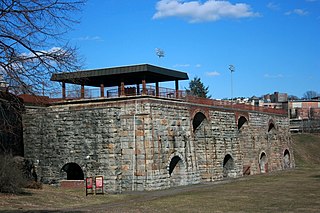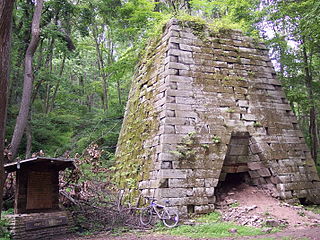
Coopers Rock State Forest is a 12,747-acre (52 km2) state forest in Monongalia and Preston counties in the U.S. state of West Virginia. Its southern edge abuts Cheat Lake and the canyon section of Cheat River, a popular whitewater rafting river in the eastern United States.

Oxford Furnace is a historic blast furnace on Washington Avenue, near the intersection with Belvidere Avenue, in Oxford, Oxford Township, Warren County, New Jersey. The furnace was built by Jonathan Robeson in 1741 and produced its first pig iron in 1743. The first practical use in the United States of hot blast furnace technology took place here in 1834. The furnace was added to the National Register of Historic Places on July 6, 1977 for its significance in industry during the 19th century. It was later added as a contributing property to the Oxford Industrial Historic District on August 27, 1992.

Roaring Creek is a tributary of the Susquehanna River in Columbia County and Montour County, in Pennsylvania, in the United States. It is slightly more than 20 miles (32 km) long and flows through Roaring Creek Township, Locust Township, Catawissa Township, Cleveland Township, and Franklin Township in Columbia County and Mayberry Township in Montour County. The watershed of the creek has an area of 87.3 square miles (226 km2). It has three named tributaries: South Branch Roaring Creek, Lick Run, and Mill Creek. The creek is not considered to be impaired and is not affected by coal mining. However, its watershed has been impacted by human land use. Claystones, conglomerates, sandstones, siltstones, and shales all occur within the watershed. The creek flows through a gorge in its lower reaches, along the border between Columbia County and Montour County.

Principio Furnace and village is in Cecil County, Maryland, 4 miles (6.4 km) northeast of Havre de Grace, MD.

The Scranton Iron Furnaces is a historic site that preserves the heritage of iron making in the U.S. State of Pennsylvania and is located in Scranton, near the Steamtown National Historic Site. It protects the remains of four stone blast furnaces which were built between 1848 and 1857. Iron production on the site was started by Scranton, Grant & Company in 1840. Later, the furnaces were operated by the Lackawanna Iron & Coal Company. In 1847, iron rails for the Erie Railroad were made at the site. In 1865, Scranton, Grant & Company had the largest iron production capacity in the United States. In 1875, steel production started at the site. In 1880, the furnaces produced 125,000 tons of pig iron, one of the main uses of which was in the making of t-rails. The plant was closed in 1902, when production was shifted to Lackawanna, New York.

Eagle Rock is an unincorporated community in Botetourt County, Virginia, United States, located along the James River between Iron Gate and Buchanan.

Longdale Furnace is an unincorporated community located east of Clifton Forge in Alleghany County, Virginia, United States.

Glen Wilton is an unincorporated community in Botetourt County, Virginia, United States.

Henry Clay Furnace is a historic iron furnace located in Cooper's Rock State Forest near Cheat Neck, Monongalia County, West Virginia. It was built between 1834 and 1836, and is a 30-foot square, 30 feet high stone structure in the shape of a truncated pyramid. The furnace may have continued to operate until 1868 when all the Cheat River iron works ceased production. It is among the ten or more abandoned iron furnaces still existing in northern West Virginia.

Virginia Furnace, also known as Muddy Creek Furnace and Josephine Furnace, is a historic water powered blast furnace and national historic district located near Albright, Preston County, West Virginia. The district encompasses three contributing structures and one contributing site. The furnace was built in 1854, and was a "charcoal" iron furnace used to smelt iron. It is constructed of cut sandstone, and forms a truncated pyramid measuring approximately 34 feet square in plan and rising about 30 feet. The district includes the nearby wheel pit, blast machinery, and salamander. The furnace remained in operation until the 1890s, and was the last "charcoal" iron furnace to cease operating in northern West Virginia. In 1933, the Virginia Furnace was acquired by the Kingwood Chapter of the Daughters of the American Revolution who created a roadside park at the furnace site.

Mt. Torry Furnace, also known as Virginia Furnace, is a historic iron furnace located at Sherando, Augusta County, Virginia. It was built in 1804, and is a stone square trapezoid measuring 30 feet at the base and 40 feet tall. The original cold-blast charcoal stack was converted for hot blast in 1853. It shut down in 1855, then was reactivated in 1863 to support the Confederate States Army. The furnace was destroyed in June 1864 during the American Civil War by Brigadier General Alfred N. Duffié, then rebuilt in January 1865. It operated until 1884.

Callie Furnace is a historic iron furnace located near Glen Wilton, Botetourt County, Virginia. It was built as a hot-blast charcoal furnace around 1873–1874, and subsequently enlarged and converted into a coke furnace. In 1883, the stack was raised an additional five feet, and a tuyere was added. Callie Furnace went out of blast in 1884.

West Fork Furnace is a historic iron furnace and national historic district located near Floyd, Floyd County, Virginia. The district includes structural, landscape and archaeological components of a small and well preserved mid-19th-century iron furnace built about 1853. The components consist of the furnace, retaining wall, staging area, head race, wheel pit, tail race, and East Prong of Furnace Creek. The furnace remained in operation until 1855.

Washington Iron Furnace is an historic iron furnace, located in Rocky Mount, Franklin County, Virginia. The granite furnace was built around 1770, measures 30 feet on its south face, and was listed on the National Register of Historic Places in 1973. Now one of the best preserved furnaces in Virginia, it was built against the side of a hill so iron ore, charcoal and limestone could be brought by wagon and dumped into the top of the furnace, although the original cart road and ten-yard-long bridge leading to the top no longer exist.

Old Forge Farm, also known as Zane's Furnace, Stephens Fort, and Marlboro Iron Works, is a historic home and farm located near Middletown, Frederick County, Virginia. The original section dates to the 18th century. The house is a two-story, asymmetrical, three-bay, limestone dwelling with a two-story addition connecting the main house to a one-story former summer kitchen. Also on the property are the contributing 18th century hexagonal ice house of unusual design, an early 20th-century root cellar, privy, and shed. The property was first known as Stephen's Fort, built by Lewis Stephens, son of Peter Stephens, for protection during the French and Indian War. Sold in 1767 to Isaac Zane, whose Zane's Furnace was a major manufacturer of munitions for the Continental Army. Grist mill operations continued into the 1950s.

Bowstring Truss Bridge, also known as the Roaring Run Bowstring Truss Bridge and King Tubular Arch Truss Bridge, is a historic bowstring truss bridge located at the Ironto Rest Area near Ironto, Montgomery County, Virginia. It was built by the King Bridge Company in 1878, and is a single-span, four-panel tubular arch pony truss. It measures 55 feet (17 m) long, 12 feet (3.7 m) wide, and 6 feet 6 inches (1.98 m) high with an open roadway width of approximately 9 feet 6 inches (2.90 m). The bridge was partially disassembled and moved from its original location to a second site during the 1930s, where it remained until moved to its current location in 1977.

Catherine Furnace is a historic iron furnace located in the George Washington National Forest near Newport, Page County, Virginia. It was built in 1836, and is a pyramidal shaped furnace measuring 32 feet high. It was instrumental in producing high quality pig iron that was used in the Mexican War and American Civil War. The furnace was abandoned in 1885.
Accokeek Furnace Archeological Site is a historic archaeological site located near Stafford, Stafford County, Virginia. The Principio Company of Cecil County, Maryland, constructed the Accokeek Iron Furnace about 1726 on land leased from Augustine Washington, father of George Washington. After his death in 1743, his son Lawrence Washington inherited his interest in the company and furnace. When he died in 1752, his share descended to his brother Augustine Washington, Jr.. Operations at this site ceased around 1753. A historical marker denoting this site is located on the grounds of Colonial Forge High School.

The Tubal Furnace Archeological Site is the site of an early 18th century industrial iron works in Spotsylvania County, Virginia, near Chancellor. Established by colonial Lieutenant Governor Alexander Spotswood in c. 1717, the site included a furnace and waterworks. It was operated, primarily by skilled slave labor, into the early 19th century.

Hoop Hole, a wildland in the George Washington and Jefferson National Forests of western Virginia, has been recognized by the Wilderness Society as a special place worthy of protection from logging and road construction. The Wilderness Society has designated the area as a "Mountain Treasure".
























